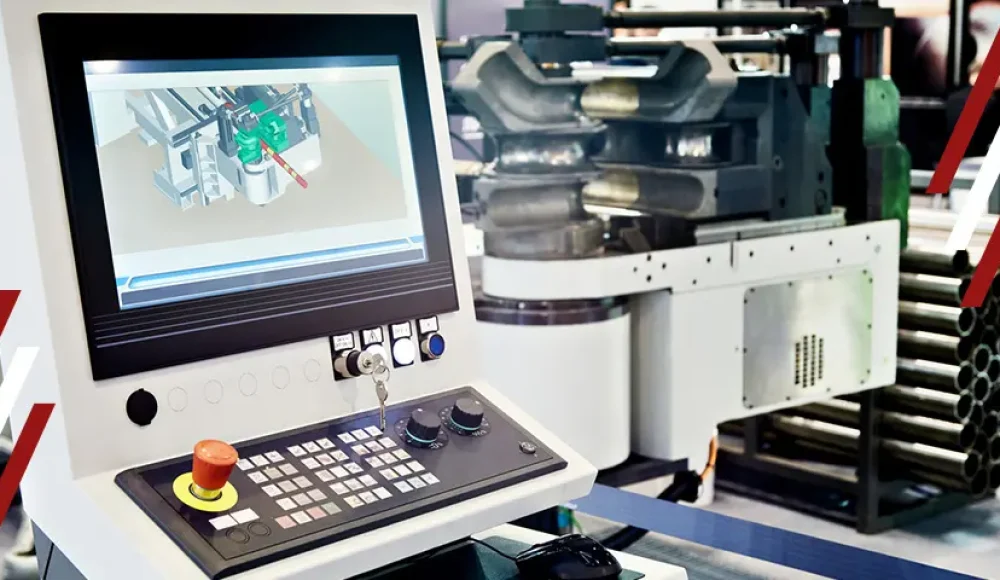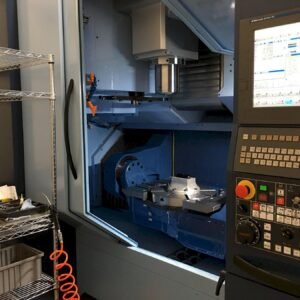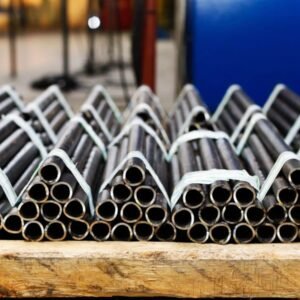Dans le rythme rapide d'aujourd'hui, Fabrication de haute précision environnement, Fabrication assistée par ordinateur (CAME) joue un rôle crucial dans la transformation des conceptions numériques en produits du monde réel avec la vitesse et la précision. De l'aérospatiale aux dispositifs automobiles et médicaux, CAM permet l'automatisation, Optimise les workflows, et réduit les erreurs de production.
Cet article explore tout ce que vous devez savoir sur CAM - qu'est-ce qu'il est, Comment ça fonctionne, Son industrie utilise, Avantages clés, outils essentiels, intégration avec d'autres systèmes, Et ce qui nous attend.
Qu'est-ce que la fabrication assistée par ordinateur?
Fabrication assistée par ordinateur (CAME) est l'utilisation de logiciels pour contrôler les machines-outils et automatiser les processus de fabrication. Le logiciel CAM traduit 2D ou 3D Conception assistée par ordinateur (GOUJAT) Modèles dans les instructions de la machine (Généralement G-Code) utilisé par Machines CNC, 3D imprimantes, Systèmes EDM, et plus.
Fonctions clés de la CAM:
Génération de parcours d'outils pour le fraisage, tournant, forage, et coupure.
Simulation des opérations d'usinage.
Contrôle des machines CNC multi-axes.
Optimisation de l'utilisation des matériaux et du temps de cycle.
Une brève histoire de CAM
1950s: Naissance Contrôle numérique (Caroline du Nord)—Machines contrôlées par du ruban vif.
1960s: Introduction Commande numérique par ordinateur (CNC) systèmes.
1970s: Première génération de Intégration CAD / CAM pour l'automobile et l'aérospatiale.
1980S - 1990: Développement rapide des systèmes de came basés sur PC.
2000s - présent: Came basée sur le cloud, 5-usinage sur l'axe, et la surveillance en temps réel devient courant dominant.
Comment fonctionne la cam?
Commencez par un modèle CAO
Toi (ou votre ingénieur) Concevoir la pièce à l'aide du logiciel CAO. C'est comme esquisser quelque chose en 3D sur votre ordinateur.
Importer la conception dans le logiciel CAM
Une fois votre pièce conçue, Vous ouvrez ce fichier dans un programme CAM comme MasterCam ou Fusion 360. C'est là que la véritable planification commence.
Configurer la stratégie d'usinage
Vous dites au logiciel comment Pour faire la pièce. Cela comprend des outils de sélection (comme des bits de forage ou des moulins), Choisir à quelle vitesse ils devraient se déplacer, et décider où ils devraient couper.
Générer des parcours d'outils
Le logiciel CAM dessine de petites «routes» (appelés parcours d'outils) qui montrent la machine exactement où aller et quoi faire - Couper, forage, sculpture, etc..
Convertir en G-Code
CAM transforme alors toutes ces parcours d'outils en une langue spéciale appelée Code G - c'est comme les instructions étape par étape de la machine.
Envoyer le code à la machine
Vous chargez le code G dans une machine CNC. Il lit ces instructions et commence à couper votre partie du métal, plastique, ou quel que soit le matériel que vous utilisez.
Laissez la machine faire son truc
La machine fait le travail: filage, Coupe, mobile, et façonner - tous automatiquement. Tu regardes juste, écouter, et intervenir si quelque chose ne va pas.
Applications de l'industrie de la CAM
CAM est appliqué dans presque tous les secteurs de la fabrication:
| Industrie | Applications CAM communes |
| Automobile | Blocs de moteur, moules, boîtiers de transmission |
| Aérospatial | Aubes de turbines, côtes de cellule, supports structurels |
| Médical | Implants orthopédiques, outils chirurgicaux, dispositifs dentaires |
| Électronique | Cartes PCB, dissipateurs de chaleur, boîtiers |
| Énergie | Centres d'éoliennes, tôles nucléaires, composants de la pompe |
| Consommateur | Enclos en plastique, outils, jouets |
Avantages de la CAM pour les fabricants
✅ 1. Ça fait économiser des tonnes de temps
Avec une came, Les machines suivent un programme informatique au lieu d'être contrôlé manuellement. Cela signifie que vous pouvez passer de la conception à la production super rapide - plus d'arrêt pour mesurer chaque petite coupe. Cam aide les choses à se déplacer plus rapidement, ce qui signifie plus de pièces fabriquées en moins de temps.
✅ 2. Cela rend les choses super précises
Les humains font des erreurs. Ordinateur? Pas tellement (Tant que le programme est correct!). Les machines à cames suivent les instructions exactes, donc chaque partie est cohérente et précise. C'est énorme lorsque vous faites des milliers de la même chose - ou même juste une partie avec des tolérances serrées.
✅ 3. Ça réduit les déchets
Personne ne veut jeter des matériaux chers. Les systèmes de came calculent la meilleure façon de couper et de façonner chaque pièce, Alors tu gaspille moins de métal, plastique, ou autre matériel. C'est bon pour votre budget et la planète.
✅ 4. Il est plus facile d'apporter des modifications
Besoin de modifier votre conception de pièce? Aucun problème. Mettez simplement à jour le fichier CAO, Re-run le logiciel CAM, Et tu es prêt à partir. Pas besoin de reconstruire les gabarits, réinitialiser les machines, ou commencer à zéro. Cam rend le changement entre les travaux beaucoup plus fluide.
✅ 5. Cela fonctionne avec beaucoup de machines différentes
Si vous exécutez des moulins CNC, tours, routeurs, ou même les imprimantes 3D, Cam peut le gérer. Il parle la langue de nombreuses machines - toutes du même fichier numérique.
✅ 6. C'est plus sûr pour les travailleurs
Puisque la came automatise la coupe et la mise en forme, Les opérateurs n'ont pas à se tenir juste à côté des pièces mobiles toute la journée. Cela signifie moins de chances d'accidents, blessures, ou fatigue.
✅ 7. Cela stimule la productivité
Avec des temps de configuration plus rapides, Moins de travail manuel, Et moins d'erreurs, Les fabricants peuvent en faire plus avec le même équipement. C'est une meilleure sortie, meilleurs bénéfices, Et beaucoup moins de stress.
✅ 8. C'est idéal pour des pièces complexes
J'ai un design délicat avec des courbes, trous, ou des formes inhabituelles? Cam est construit pour ça. Il est plus facile de créer des pièces qui seraient presque impossibles (ou douloureusement lent) faire à la main.
Outils logiciels CAM les plus populaires
| Logiciel | Principales fonctionnalités |
| Mastercam | Norme de l'industrie pour le fraisage, tournant, et 5 axes |
| Fusion 360 | CAD / CAM basé sur le cloud, Idéal pour les startups |
| Solide | Entièrement intégré à Solidworks |
| Camion électrique | Usinage à grande vitesse pour les moules et l'aérospatiale |
| Gibbscam | Interface intuitive pour les tours et multitâche |
| Cam nx | Plateforme de niveau d'entreprise par Siemens |
Compétences requises pour CAM
Être compétent dans la came, un opérateur ou un ingénieur doit comprendre:
Modélisation et préparation des fichiers CAD
Configuration et fonctionnement de la machine CNC
Sélection et flux / vitesses des outils
Interprétation du code G
Simulation et vérification des parcours d'outils
Dépannage et optimisation des processus
Cad to Cam Workflow: Pourquoi c'est crucial
💡 Tout d'abord, Qu'est-ce que CAD et CAM?
GOUJAT (Conception assistée par ordinateur): C'est là que vous concevez la pièce - comme dessiner un modèle 3D d'un équipement, caisse de téléphone, ou partie du moteur sur votre ordinateur.
CAME (Fabrication assistée par ordinateur): Cela prend votre conception numérique et le transforme en instructions à suivre pour les machines -, il dit à la machine comment couper, percer, ou façonnez votre pièce.
📌 Pourquoi ce flux de travail est-il si important?
✅ 1. C'est comme passer du plan du plan au plan d'action
Considérez CAD comme le plan, et Cam comme plan d'action étape par étape. Sans Cad, Il n'y a pas de design. Sans caméra, La machine ne sait pas quoi faire. Ensemble, Ils transforment votre idée en produit physique - rapidement et avec précision.
✅ 2. Ça fait économiser des tonnes de temps
Vous n'avez pas besoin de réintégrer manuellement les détails de conception dans la machine. Une fois votre modèle CAO terminé, Vous pouvez l'importer directement dans le logiciel CAM. C'est un énorme gain de temps - et beaucoup moins de chances d'erreur humaine.
✅ 3. Il garde tout cohérent
J'ai déjà essayé de faire 100 pièces identiques à la main? Pas facile. Mais avec un système CAD TO CAM, La machine suit les mêmes étapes exactes à chaque fois, Alors chaque pièce sort juste.
✅ 4. Cela facilite les changements de dernière minute
A changé d'avis sur une taille ou une forme de trou? Aucun problème. Il suffit de modifier le fichier CAO, régénérer les instructions CAM, Et tu es prêt à partir. Pas de recommandation de zéro.
✅ 5. Cela vous aide à travailler plus intelligent, Pas plus difficile
Le workflow CAD to CAM est super efficace. Il vous aide à planifier à l'avance - choisir les bons outils, vitesses, et couper les chemins avant même le début du travail. Cela signifie moins d'erreurs, meilleure finition de surface, et moins de déchets de matières.
CAM VS. CNC VS. Cae: Quelle est la différence?
| Terme | Description |
| CAME | Transforme CAD en instructions de la machine |
| CNC | Fait référence à la machine-outil qui lit le code G |
| Cae | Utilise la simulation pour tester les conceptions pour le stress, chaleur, etc.. |
Considérez CAD comme l'idée, Cam comme plan, CNC Comme l'action, et Cae comme chèque de sécurité.
Tendances futures en came
🤖 Caméra alimentée par Ai: Optimisation automatisée des paroles et des stratégies.
☁️ Plates-formes basées sur le cloud: Collaboration et évolutivité en temps réel.
🧠 Maintenance prédictive: Utilisation des données du capteur pour réduire les temps d'arrêt.
🖨 Came hybride (Additif + Soustraire): Mélanger l'impression 3D avec fraisage.
🔄 Rétroaction en boucle fermée: Ajustements en temps réel pendant l'usinage.
Conclusion
La fabrication assistée par ordinateur est plus que des logiciels - c'est un outil de transformation qui remodele le fonctionnement de la fabrication moderne. CAM permet une production plus rapide, déchets inférieurs, précision plus élevée, et une plus grande adaptabilité.
Alors que les industries continuent d'évoluer et de numériser, CAM jouera un rôle de plus en plus critique pour aider les fabricants à répondre à la demande de pièces complexes, tolérances plus étroites, et production durable.



